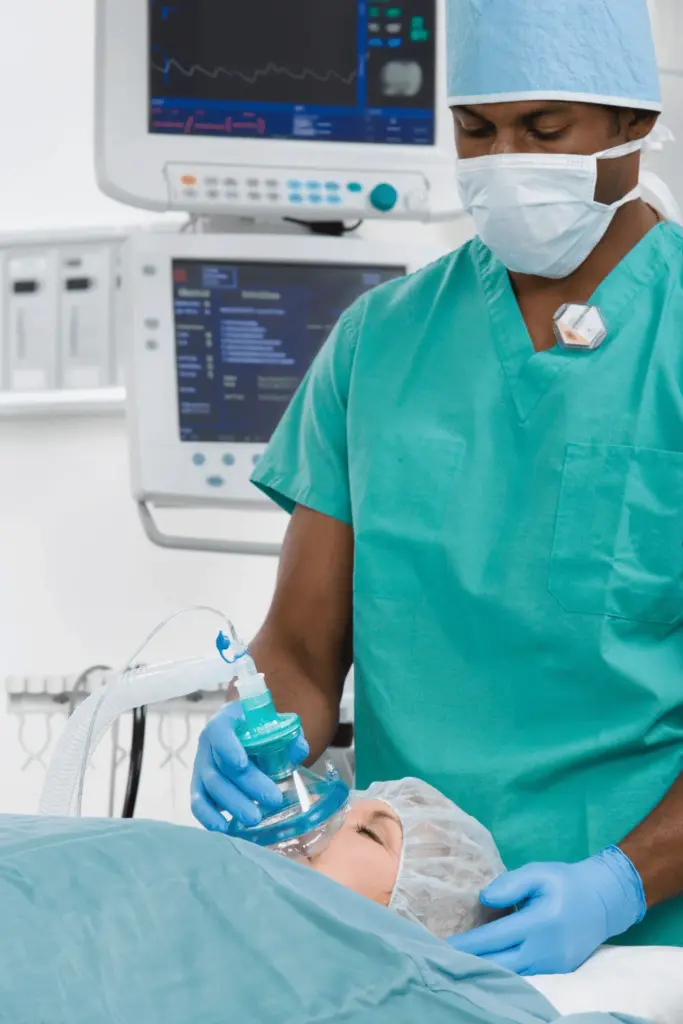There are two main approaches to managing pain and consciousness during plastic surgery: general anesthesia vs. sedation.
While both methods have their place in modern medicine, they differ significantly in their effects, applications, and patient experiences. The choice between general anesthesia and sedation can impact factors such as the procedure’s complexity, recovery time, and overall experience.
General Anesthesia vs. Sedation: What is General Anesthesia and How Does It Work?

General anesthesia is a medically induced state of unconsciousness that renders a patient completely unaware and unresponsive to external stimuli. Its primary purpose is to provide a deep level of sedation and analgesia for complex or lengthy surgical procedures, ensuring that patients remain still and pain-free throughout the operation.
The process of administering general anesthesia vs sedation typically involves a combination of intravenous drugs and inhaled gasses. An anesthesiologist or certified registered nurse anesthetist (CRNA) carefully calculates and administers these medications based on factors such as the patient’s age, weight, health status, and the nature of the procedure.
The initial medications are usually given through an IV, followed by the introduction of inhaled anesthetics once the patient is unconscious.
General anesthesia affects multiple systems in the body and brain. It:
- Depresses the central nervous system, leading to a loss of consciousness and the inability to form new memories during the procedure.
- Suppresses pain signals, relaxes muscles, and often requires assistance with breathing through intubation or other airway management techniques.
- Affects the cardiovascular system, necessitating close monitoring of vital signs throughout the procedure.
Types of Anesthesia

There are several types of general anesthesia, each with its own characteristics and applications:
- Inhalation anesthesia: Delivered through a mask or breathing tube, these gasses (such as sevoflurane or desflurane) are often used for the maintenance of anesthesia. They are easily titratable, allowing for quick adjustments in anesthetic depth.
- Intravenous (IV) anesthesia: Medications like propofol or etomidate are injected directly into the bloodstream. IV sedation vs. general anesthesia is commonly used for induction of anesthesia and can also be used for maintenance in certain procedures.
- Total Intravenous Anesthesia (TIVA): This technique uses only IV medications for both induction and maintenance of anesthesia, avoiding inhaled agents altogether.
- Balanced anesthesia: A combination of inhaled and IV agents, often including opioids for pain control, is used to achieve the desired anesthetic effect.
Each type has its advantages and is chosen based on the specific needs of the patient and procedure. For instance, TIVA may be preferred for patients prone to postoperative nausea and vomiting, while inhalation anesthesia allows for rapid emergence in shorter procedures.
What is Sedation and How Does It Work?

Sedation is a drug-induced state of relaxation and reduced awareness. Unlike general anesthesia, sedation aims to keep patients calm and comfortable while maintaining varying levels of consciousness. It is primarily used for less invasive procedures or as an adjunct to local anesthesia.
Sedation is typically administered through IV medications, although oral or intranasal routes may be used in certain situations. Common sedative agents include benzodiazepines (like midazolam), propofol, and dexmedetomidine. The choice and dosage of medication depend on the desired level of sedation and the patient’s individual characteristics.
The effects of sedation on the body and consciousness levels can vary widely depending on the depth of sedation achieved. At lower levels, patients may feel relaxed and drowsy but remain responsive. Deeper levels of sedation can approach a state similar to general anesthesia, with significant depression of consciousness and reflexes.
Unlike general anesthesia, however, even deep sedation does not typically require airway intervention, and patients often maintain their ability to breathe independently.
Types of Sedation
Sedation is generally classified into three main levels:
- Minimal sedation (anxiolysis): Patients remain awake and responsive but experience reduced anxiety. This level is often achieved with oral medications and is suitable for minor procedures or anxious patients undergoing non-invasive treatments.
- Moderate sedation (conscious sedation): Patients enter a state of drowsiness but can still respond to verbal commands or light touch. This level is commonly used for endoscopies, dental procedures, and some cosmetic treatments.
- Deep sedation: Patients are difficult to rouse and may only respond to repeated or painful stimuli. This level approaches general anesthesia and is used for more invasive procedures that don’t require complete unconsciousness.
Minimal sedation offers the quickest recovery and lowest risk but may not be sufficient for more complex procedures. Deep sedation provides a higher level of comfort and amnesia but requires closer monitoring and has a potential risk of complications.
Key Differences: Sedation vs. General Anesthesia

Level of Consciousness
General anesthesia induces a state of complete unconsciousness, where patients are unaware of their surroundings and unable to respond to stimuli. In contrast, sedation exists on a spectrum, ranging from minimal sedation (where patients are awake but relaxed) to deep sedation (where patients are unconscious but can be roused with significant stimulation).
Under general anesthesia, patients have no awareness or memory of the procedure, while sedated patients may have varying degrees of awareness and potential for memory formation, depending on the sedation level.
The level of consciousness has important implications for procedure complexity and duration. General anesthesia allows for longer, more complex procedures that require complete immobility and lack of patient response. Sedation anesthesia vs general anesthesia is more suitable for shorter, less invasive procedures where some patient cooperation may be beneficial.
Pain Management
General anesthesia provides complete pain control during the procedure and often includes longer-acting pain medications to manage immediate post-operative discomfort. The patient is entirely unaware of pain signals during the surgery.
Pain management in sedation varies with the level of sedation. Minimal to moderate sedation is often combined with local anesthesia for pain control. Deep sedation may provide significant pain relief but may still require additional local anesthesia for optimal comfort.
These differences in pain management capabilities affect patient comfort and procedure options. General anesthesia allows for more extensive and potentially painful procedures, while general sedation (vs general anesthesia) is often sufficient for less invasive treatments when combined with appropriate local anesthesia.
Duration and Recovery Time
General anesthesia typically allows for longer procedures, often lasting several hours. Sedation is more commonly used for shorter procedures, usually under two hours, though deep sedation can sometimes be maintained for longer periods.
Recovery time differs significantly between the two. After general anesthesia, patients usually require several hours in a recovery room before being discharged and may experience grogginess for 24-48 hours. Sedation recovery is generally quicker, with patients often able to leave the facility within an hour after lighter levels of sedation.
These differences in recovery time impact the patient’s return to normal activities. After general anesthesia, patients are advised not to drive for at least 24 hours and may need a day or two before returning to work. With sedation anesthesia vs general, especially lighter levels, patients may be able to resume normal activities the same day or the following day.
Monitoring Requirements
Patients under general anesthesia require continuous, comprehensive monitoring of vital signs, including heart rate, blood pressure, oxygen saturation, end-tidal CO2, and temperature. An anesthesiologist or CRNA must be present throughout the procedure to manage the patient’s airway and adjust anesthesia levels as needed.
Monitoring requirements for sedation vary with the depth of sedation. Minimal sedation may only require intermittent monitoring of vital signs, while deep sedation necessitates continuous monitoring similar to general anesthesia, though usually without the need for airway management.
These monitoring needs affect the medical team and facility requirements. General anesthesia typically requires a fully equipped operating room and a dedicated anesthesia provider. Sedation can often be administered in less complex settings, such as outpatient clinics or dental offices, depending on the level of sedation and the procedure being performed.
Factors Influencing the Choice Between General Anesthesia and Sedation

Type of Procedure
The complexity and duration of a procedure are primary factors in choosing between general anesthesia and sedation. More complex, lengthy, or invasive procedures typically require general anesthesia to ensure patient immobility and comfort throughout the surgery.
Procedures often requiring general anesthesia include:
- Major abdominal surgeries
- Thoracic surgeries
- Neurosurgeries
- Lengthy plastic surgery procedures (e.g., full body lifts, extensive facial reconstructions)
Procedures commonly performed under sedation include:
- Endoscopies
- Minor plastic surgery procedures (e.g., minor facial procedures, some liposuction)
- Dental procedures
- Cataract surgery
Patient’s Medical History
Pre-existing medical conditions significantly influence anesthesia choices. Patients with severe cardiovascular or respiratory issues may be at higher risk under general anesthesia vs sedation, making sedation a safer option in some cases.
A thorough medical history review is crucial to identify potential risks and contraindications. This includes evaluating current medications, allergies, previous reactions to anesthesia, and overall health status.
Specific conditions that might contraindicate certain anesthesia options include:
- Sleep apnea (may increase risks with deep sedation or general anesthesia)
- Morbid obesity (can complicate airway management in general anesthesia)
- Certain neuromuscular disorders (may affect response to anesthetic agents)
- Advanced age (may influence choice due to increased sensitivity to anesthetics)
Patient Preferences
Patient comfort and anxiety levels play a significant role in decision-making. Some patients may prefer the complete unawareness offered by general anesthesia, while others may feel more comfortable remaining partially aware under sedation.
Addressing patient concerns about each option is crucial. This may involve explaining the safety protocols in place, discussing the experience of waking up from anesthesia, and detailing the recovery process for each option.
Patient education is key to making an informed choice. Our team always provides our patients with clear, comprehensive information about the risks and benefits of each option empowering patients to participate actively in their care decisions.
Plastic Surgeon’s Recommendation
The plastic surgeon‘s expertise is crucial in recommending the most appropriate anesthesia option. They consider factors such as:
- The specific requirements of the procedure
- The patient’s overall health and risk factors
- The expected duration of the surgery
- The need for patient cooperation during certain stages of the procedure
Making the Right Choice for Your Plastic Surgery Procedure with Dr. Adrian Lo
Dr. Adrian Lo is a board-certified and award-winning plastic surgeon with extensive experience in a wide range of aesthetic and reconstructive procedures. His expertise extends to working with various anesthesia options to ensure optimal patient safety and comfort.
During the consultation process, Dr. Lo takes the time to thoroughly discuss anesthesia options with his patients. Dr. Lo explains the benefits and potential risks of each approach, answers questions, and addresses any concerns. This collaborative approach ensures that patients feel informed and comfortable with their anesthesia choices.
In today’s world of modern medicine and anesthesia, having general or twilight sedation is extremely safe and risks are extremely low.
We’re here at our Philadelphia plastic surgery offices to answer any and all of your plastic surgery questions – contact us today!
